Giro d'Italia 2019 route revealed
Final time trial in Verona balances out five mountain finishes
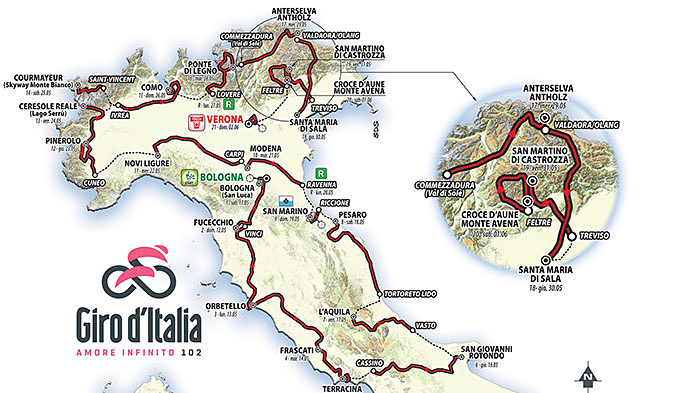
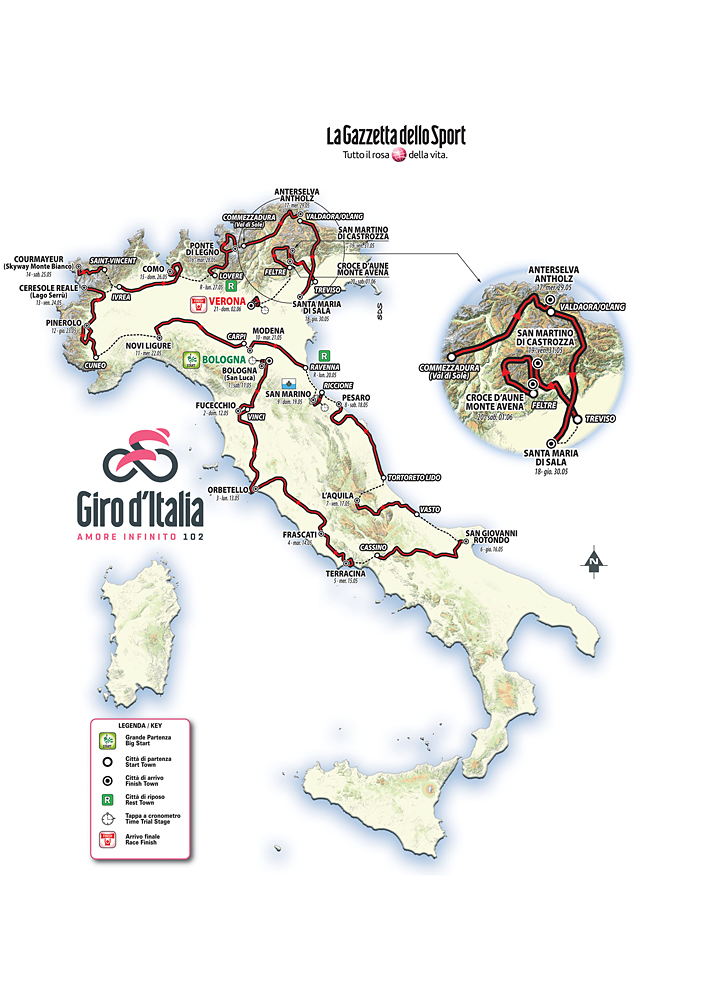
The 2019 Giro d'Italia route has been unveiled in Milan, with the 102nd edition of the Corsa Rosa offering a finely balanced but testing route that includes three individual time trials and five mountain finishes. The winner of the maglia rosa will be crowned in the Verona amphitheatre after a decisive 15.6km time trial.
After the Israel Grand Partenza in 2018, the 2019 Giro d'Italia will stay in Italy, apart from a brief visit to the enclave republic of San Marino for the uphill finish of the stage 9 time trial. The 21 stages cover a total distance of 3,518km, with the start in Bologna on Saturday, May 11, and the finish in Verona on Sunday, June 2.
The route includes legendary climbs such as the Passo Gavia, the Passo del Mortirolo and the Passo Manghen, and other lesser-known climbs that are as equally tough. Stage 13 ends with the stunning Colle del Nivolet up to Lake Serru', while stage 14 is short at 131km with four steep climbs, including the Colle San Carlo – a twisting 10.5km climb at 9.8 per cent. Stage 15 to Como is a replica of the Il Lombardia finale with the Ghisallo Colma di Sormano and Civiglio.
The final week offers just one chance for the few sprinters that are expected to stay in the race, with the final mountain stages to Ponte de Legno – which includes the Passo del Mortirolo just 27km from the finish – Anterselva, San Martino di Castrozza in the shadow of the Dolomites and then the Croce d'Aune the day before the conclusive Verona time trial.
Defending champion Chris Froome (Team Sky) was at the presentation in Milan, where the audience watched a video of this year's race highlighting his incredible attack over the dirt road Colle delle Finestre and 80km solo ride to Jafferau above Bardonecchia.
Froome was diplomatically coy about returning to defend the maglia rosa in 2019, as he eyes a fifth Tour de France victory. Team Sky is expected to send Egan Bernal and Gianni Moscon to the Giro d'Italia, with Geraint Thomas reportedly contemplating a possible Giro-Tour double.
Vincenzo Nibali was absent from the presentation as he finishes his holidays in Zanzibar. However, he could be the biggest name on the final start list, along with Fabio Aru (UAE Team Emirates), Simon Yates (Mitchelton-Scott) and Bernal, as Nibali's expected rivals. The route arguably suits former winner Tom Dumoulin, but he and Team Sunweb seem focused on the Tour de France after his second place this year.
Get The Leadout Newsletter
The latest race content, interviews, features, reviews and expert buying guides, direct to your inbox!
Elia Viviani (Quick-Step Floors) won four stages and the points jersey at the 2018 Giro d'Italia but struggled to see more than five sprint stages.
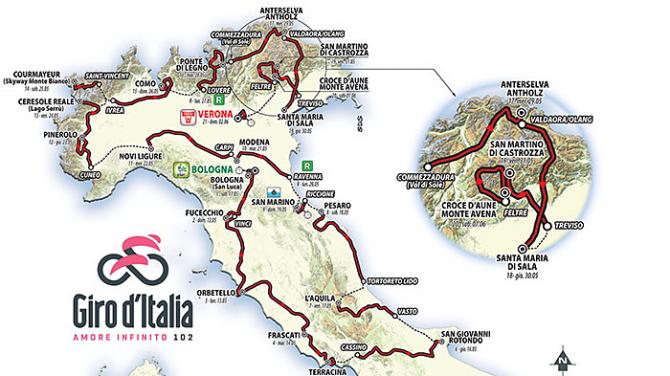
Hilly time trial start in Bologna
Race organisers, RCS Sport had already announced the Grande Partenza in Bologna, the stage 9 time trial to San Marino and a sprint stage to Modena as part of an agreement with the central Emilia Romagna region.
Vegni filled in the dots on the map of Italy, confirming the trip into Tuscany and then south via Lazio with stage 6 to San Giovanni Rotondo, the southern-most point on the calf of the Italian peninsula.
Bologna has been the site of the Grande Partenza on one previous occasion, in 1994, when Endrio Leoni won the morning road stage before the late Armand De Las Cuevas took over the maglia rosa in the afternoon time trial. Next year's opening 8.2km time trial will immediately test the overall contenders with the climb up to the Santuario della Madonna di San Luca ending with two kilometres at 9.7 per cent.
Stage 2 hops over the Apennines to Fucecchio, with stage 3 starting in Vinci to celebrate the 500th anniversary of the death of Leonardo da Vinci. The sprinters get their chances in Orbitello, Frascati and Terracina on the way south, with three subsequent stages to San Giovanni Rotondo, L'Aquila - 10 years after a terrible earthquake hit the Abruzzo city, and Pesaro on the Adriatico coast more suited to late attacks and the likes of Peter Sagan due to a hilly finale.
The 34.7km time trial to San Marino starts on the coast in Riccione and is the 'wine stage' of the 2019 Giro d'Italia, celebrating the red Sangiovese wines of the area. The road is flat and fast until Faetano for the first 22km but then climbs up to San Marino. It will be interesting to see if riders opt to change bikes mid-stage.
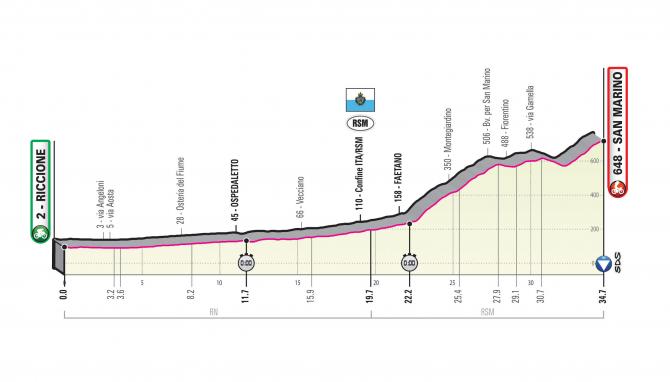
Into the mountains
The riders will enjoy the first rest day between San Marino, with two pan-flat stages to Modena and then across to Piemonte in Novi Ligure – the birthplace of Italian legends Costante Girardengo and Fausto Coppi.
It has been 70 years since Coppi won the Cuneo to Pinerolo stage of the 1949 Giro d'Italia, riding 192km alone through the Alps to set up overall victory. Disappointingly, the 2019 race covers far easier climbs on the road to Pinerolo, with the Montoso climb the only difficulty of the 146km stage.
The real mountains begin on stage 13 with the 2,247-metre-high finish on the testing roads of the Colle del Nivolet to Lake Serrù, close to the spectacular Gran Paradiso. The Colle del Nivolet has rarely been used in races but is famous for the final scenes of the movie The Italian Job.
Stage 13 from Saint Vincent to Courmayeur is short at 131km but intense with four steep climbs and a final kick to the foot of the Monte Bianco Skyway. It could be the hardest stage of the 2019 Giro d'Italia with early gradients in the double digits on the Colle San Carlo likely to inspire attacks.
Nibali will be happy to see stage 15 cover the same climbs as Il Lombardia, with the descent of the Civiglio likely to be as important as the climb.
The riders will enjoy the second rest day near Bergamo before climbing high into the Eastern Alps via the legendary Passo di Gavia, where Andy Hampsten gained time on his rivals in the snow to win the 1988 Giro d'Italia, and the Mortirolo where Marco Pantani often showed his style of attacking out of the saddle to conquer the 12 per cent middle section. At 226km, the stage has rightly been given five stars by RCS Sport, with the Passo Gavia, at 2,618m, awarding the Cima Coppi prize for the highest climb of the race.
The final stages stay in the mountains of northern Italy with stage 17 crossing the Val di Sole apple orchards to Anterselva. Only stage 18 to Santa Maria di Sala near Venice suits the sprinters and breakaway attempts, with stage 19 heading back into the mountains for a fast climb to San Martina di Castrozza south of the spectacular Dolomites.
Stage 20 brings the final mountain stage - from Feltre to the Passo Croce d'Aune - covering 193km in a long loop. It starts with the little-known Cima Campo, which leads to the 18.9km Passo Manghen. The Fiemme valley leads to the Passo Rolle and a long descent takes the riders to the foot of the 13.5km climb up to above Croce d'Aune. A statue marks the point where Tullio Campagnolo struggled to change a wheel during a race in 1927 and was inspired to create the quick-release lever, but the climb kicks up even further with six kilometres, to 8.8 per cent, before a quick descent to the finish line.
Whoever wears the maglia rosa there will then have to defend on the final stage 15.6km time trial around Verona. The stage is far from flat, with the Toricelle climb limiting the time gains of the better time triallists.
The winner of the 2019 Giro d'Italia will be crowned inside the Roman amphitheatre, just as in 1981, when Giovanni Battaglin defended the pink jersey, in 1986 when Francesco Moser used disc wheels and his Hour Record preparation to snatch victory from Laurent Fignon, and in 2010 when Ivan Basso won his second Giro d'Italia.
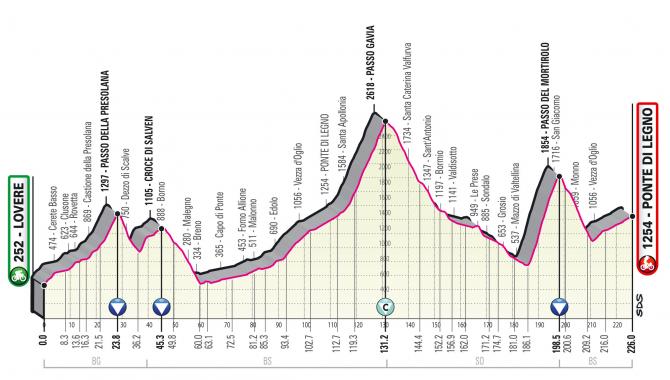

Stephen is one of the most experienced member of the Cyclingnews team, having reported on professional cycling since 1994. He has been Head of News at Cyclingnews since 2022, before which he held the position of European editor since 2012 and previously worked for Reuters, Shift Active Media, and CyclingWeekly, among other publications.